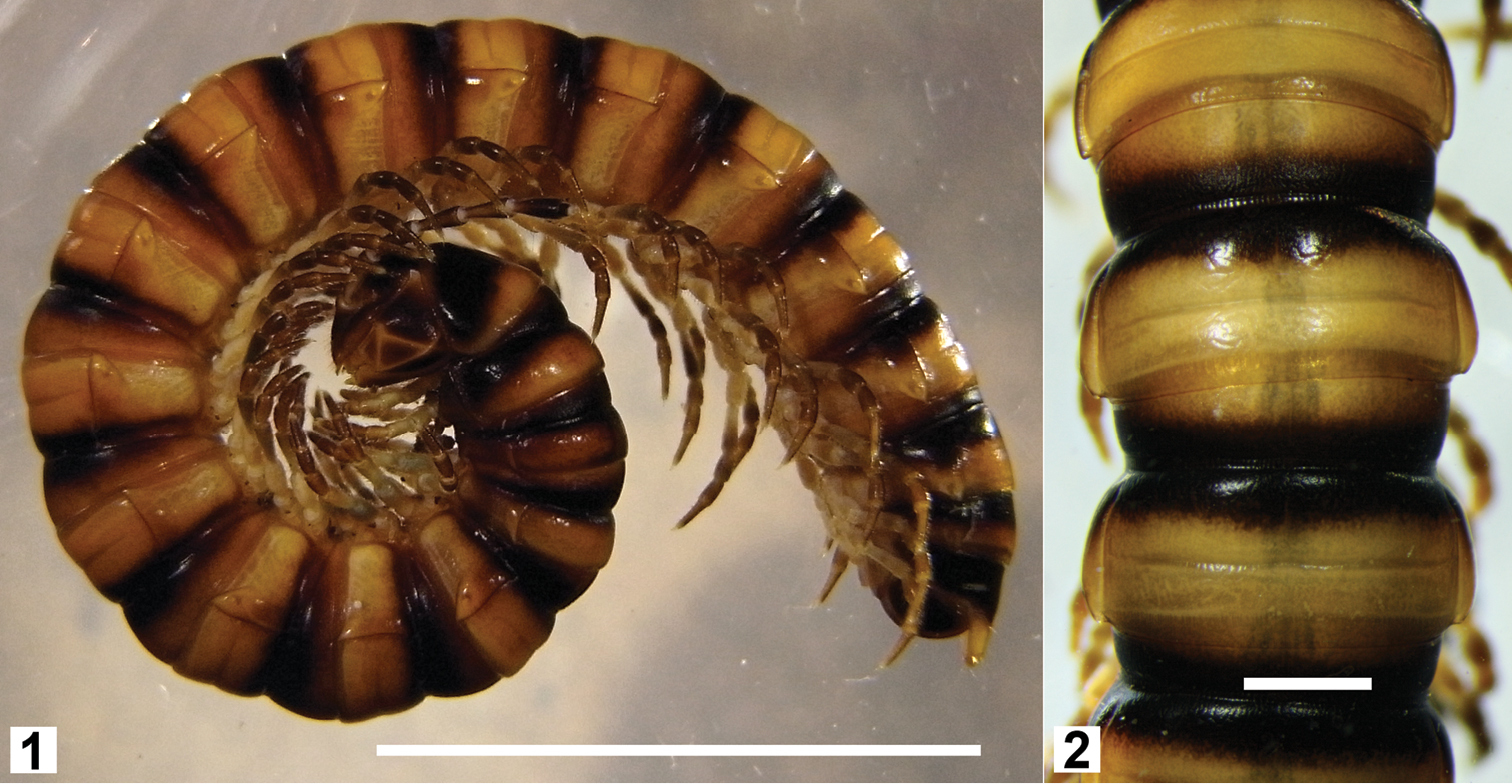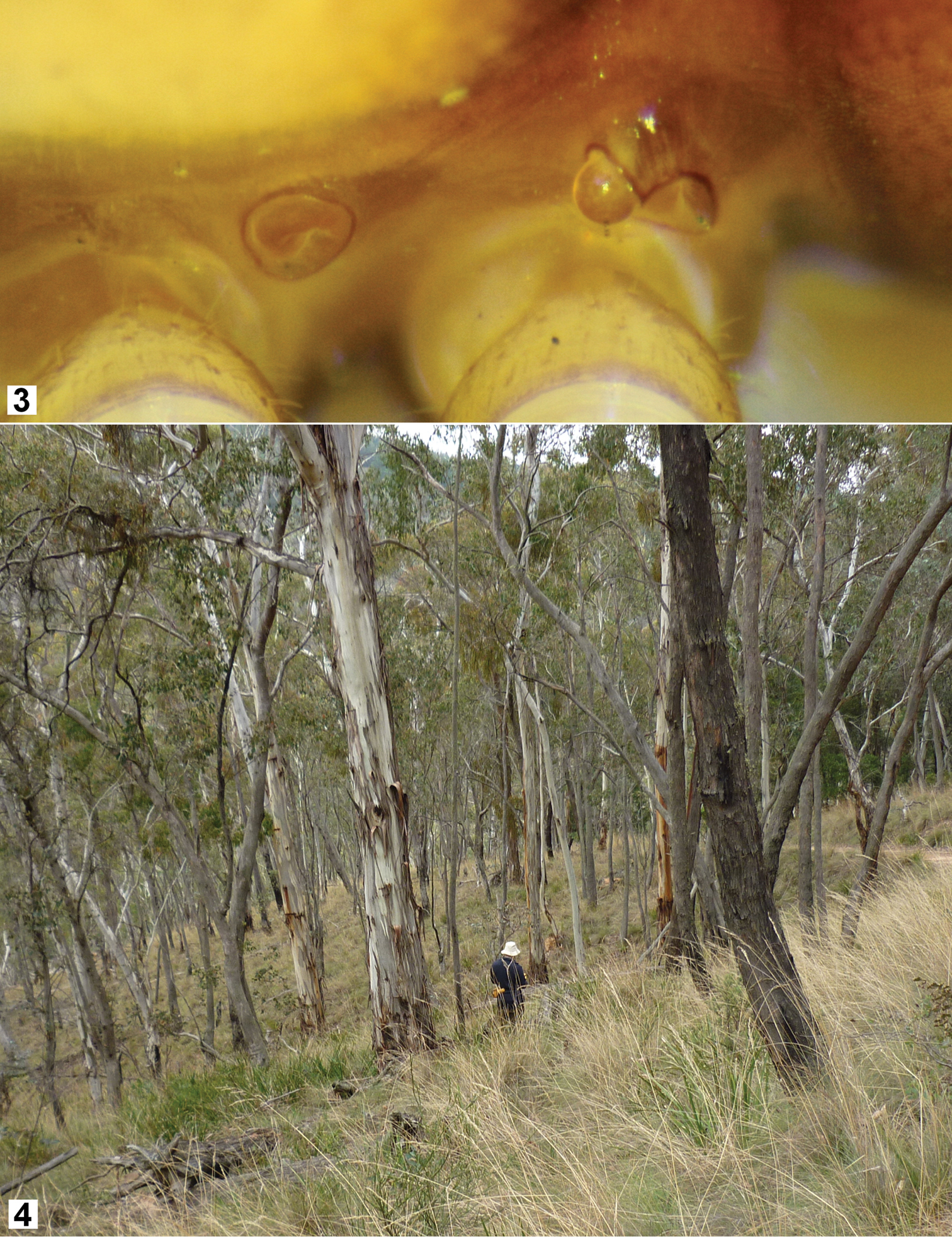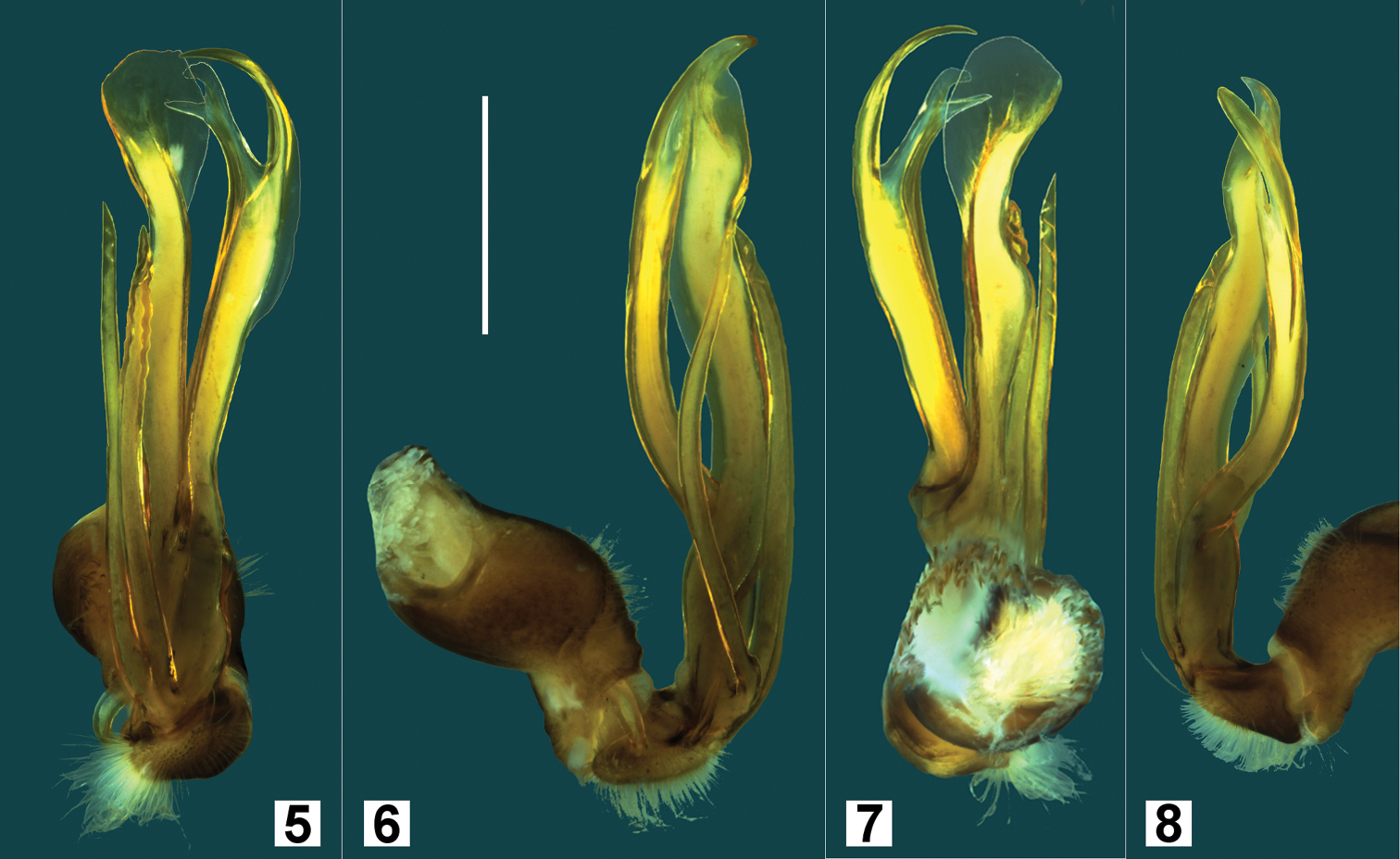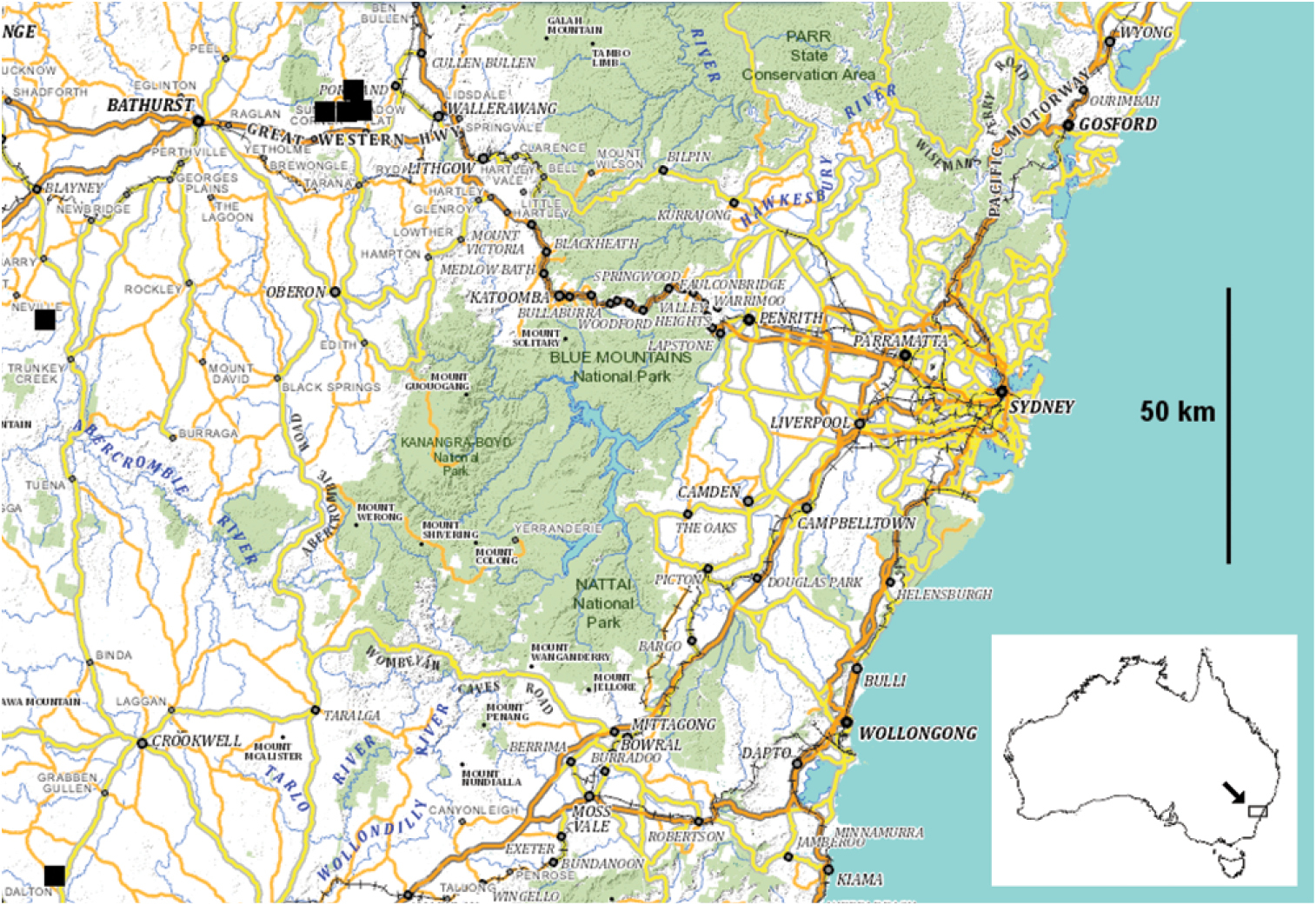






(C) 2013 Robert Mesibov. This is an open access article distributed under the terms of the Creative Commons Attribution License 3.0 (CC-BY), which permits unrestricted use, distribution, and reproduction in any medium, provided the original author and source are credited.
For reference, use of the paginated PDF or printed version of this article is recommended.
Citation: Mesibov R, Car CA (2013) Hoplatessara luxuriosa (Silvestri, 1895) (Diplopoda, Polydesmida, Paradoxosomatidae) is native to Australia, not New Guinea. ZooKeys 329: 1–8. doi: 10.3897/zookeys.329.5976
Hoplatessara luxuriosa (Silvestri, 1895) is partly redescribed and illustrated. Its native range is shown to be in the cool-climate uplands of New South Wales, Australia. H. luxuriosa was originally labelled as collected by L.M. D’Albertis at Sorong in New Guinea. D’Albertis collected on Sorong Island in 1872 and spent the following year in Sydney, New South Wales, before returning to Europe with his New Guinea specimens. It is possible that D’Albertis himself collected H. luxuriosa in 1873, and that the mislabelling occurred later.
Diplopoda, Polydesmida, Paradoxosomatidae, New South Wales, Australia, L.M. D’Albertis
The native range of the millipede Hoplatessara luxuriosa (Silvestri, 1895) has long been uncertain. It was first described as Strongylosoma luxuriosum by
Specimens are stored in ethanol in the Australian Museum. Fig. 1 was taken with a Ricoh GX200 and Figs 2 and 3 with a Canon EOS 1000D digital SLR camera mounted on a Nikon SMZ800 binocular dissecting microscope equipped with a beam splitter. Figs 1-3 are manually stacked composites processed with Zerene Stacker 1.04. Figs 5-8 were generated with a Leica MZ16A automontage imaging system using Leica Application Suite Version 3.7.0. Final figures were prepared using GIMP 2.8 image editing software. The latitude/longitude datum for collection details is WGS84. Abbreviations: AM = Australian Museum, Sydney, Australia; MCG = Museo Civico di Storia Naturale, Genoa, Italy; NSW = New South Wales, Australia.
Hoplatessara luxuriosa (Silvestri, 1895), female ex AM KS.120531. Whole animal (1, scale bar = 10 mm) and dorsal view of midbody rings (2, scale bar = 1 mm).
3 Hoplatessara luxuriosa (Silvestri, 1895), female ex AM KS.120531, right lateral view of midbody spiracles (anterior to right) 4 Grassy forest habitat of Hoplatessara luxuriosa (Silvestri, 1895) along Daylight Creek Road near Sunny Corner, NSW, on 30 April 2013.
http://species-id.net/wiki/Hoplatessara_luxuriosa
Figs 1–3, 5–8Male, lacking segments 8 and 9, Sorong, New Guinea [see Discussion], L.M. D’Albertis, MCG.
1 female, 1 female fragment, 1 male fragment, same details, MCG.
1 male, Sunny Corner State Forest near Bathurst, NSW, 33°24'S, 149°51'E ±2 km, 4 December 1972, J.S. Disney, under pine log, AM KS.18542; 1 male, near Merrill, SW of Crookwell, NSW [locality text not on label], 34°40'S, 149°17'E ±2 km, 20 April 1990, [collector uncertain], AM KS.106310; 6 males, 2 females, 1 juvenile, 5 km NE of Colo, NSW [locality text not on label], 33°45'S, 149°17'E ±2 km, 653 m a.s.l., 20 April 1990, L. Kirwan, AM KS.106320; 2 males, Sunny Corner near Bathurst, NSW, 33°24'S, 149°53'E ±2 km, 24-27 January 1997, S.J. Fellenberg, AM KS.96088; 1 male, 1 female, 1 stadium 7 female, Daylight Creek Road near Sunny Corner, NSW, 33°21'51"S, 149°53'39"E ±100 m, 1050 m a.s.l., 30 April 2013, R. Mesibov and T. Moule, AM KS.120531; 1 male, 1 female, Sunny Corner Road near Sunny Corner, NSW, 33°23'58"S, 149°54'22"E ±25 m, 1210 m a.s.l., same date and collectors, AM KS.120532.
Live and freshly preserved males and females (Figs 1, 2) with pale brownish-yellow ground colour, lighter ventrally; darker brown on prozonites and anterior portion of metazonites, darkest at waist and dorsally; head dark brown dorsally, lightening ventrally; collum dark brown ringed with pale brownish-yellow; antennae dark brown, lighter basally; legs with coxae, prefemur and basal portion of femur pale yellow, and postfemur, tibia and tarsus brown, darkening distally; preanal ring dark brown with pale yellow epiproct; hypoproct light brown, anal valves dark brown ringed with pale brownish-yellow.
Small pleural keels on female rings 2–4, more prominent on rings 3 and 4; traces of keels on male rings 2–4.
Male ring 6 sternite with transverse brushes of long setae between legpairs 6 and 7. Male ring 5 sternite with sparse transverse brush of long setae between legpair 5, well-separated from sternal lamella between legpair 4.
Spiracles on diplosegments of males and females well-separated (Fig. 3); posterior spiracle crater-like, anterior spiracle rim oval (long axis more or less dorsoventral), dorsal portion of rim extended posterolaterally around emergent, finely textured, subspherical spiracle.
Gonopods (Figs 5–8) as described by
Hoplatessara luxuriosa (Silvestri, 1895), male ex AM KS.120532. Posterior (5), medial (6), anterior (7) and lateral (8) views of left gonopod, not to same scale. Scale bar in Fig. 6 = 1 mm.
Occurs in the high country west of the Blue Mountains in New South Wales (Fig. 9) in grassy eucalypt forest (Fig. 4) and plantations of Pinus radiata, where adults were found in 2013 sheltering under logs and small pieces of fallen wood or bark. We have not yet confirmed by further collecting the two 1990 localities south of Bathurst (Fig. 9); if these are correct, the north-south range of Hoplatessara luxuriosa is ca 150 km.
Localities for Hoplatessara luxuriosa (Silvestri, 1895) as of 30 April 2013 (black squares). Inset shows location of main map. Base map from the Spatial Information Exchange, New South Wales Department of Finance and Services (http://maps.six.nsw.gov.au/ [accessed 9 July 2013]), showing named localities mentioned in text.
The structure of the anterior spiracle on diplosegments (Fig. 3) is very similar to that found in other australiosomatine paradoxosomatids [see figs 2A, 2B, 3C in
The known Hoplatessara luxuriosa range (Fig. 9) is in the cool, dry ‘Central Tablelands’ region of New South Wales.
Long-term climate averages for the town of Lithgow, ca 25 km southeast of the collection localities near Sunny Corner and ca 250 m lower in elevation, are 0.7/10.4°C (mean minimum/mean maximum) in the coldest month (July) and 11.9/25.5 in the warmest month (January), with a mean annual rainfall of 858 mm well-distributed through the year (Australian Bureau of Meterorology, http://www.bom.gov.au/climate/averages/tables/cw_063224.shtml [accessed 9 May 2013]). Frosts and light winter snowfalls are common events in the area.
In comparison, average night/day temperatures in Sorong, Indonesia are ca 25/31°C throughout the year, and the well-distributed annual rainfall is 2840 mm (http://www.weatherbase.com/weather/weather.php3?s=20579 [accessed 9 May 2013]). It seems highly unlikely that Hoplatessara luxuriosa could occur naturally in Sorong, or establish there if introduced. How, then, did the New South Wales specimens examined by Silvestri and Jeekel come to be labelled ‘Sorong’?
On his first expedition to New Guinea, the Italian naturalist and explorer L.M. D’Albertis arrived on Sorong Island (close to the coast and near the modern-day city of Sorong) at the end of April 1872 and based himself there until mid-July, collecting birds and insects (
It is possible that D’Albertis himself collected Hoplatessara luxuriosa during his long stay in New South Wales in 1873, and that the specimens were unintentionally mixed with those from Sorong Island, or kept separate and later mislabelled. The Main Western line of the New South Wales railways had reached the eastern edge of the known Hoplatessara luxuriosa range at Wallerawang in 1870 and Tarana in 1872 (http://www.nswrail.net/lines/show.php?name=NSW:main_west [accessed 11 May 2013]; see Fig. 9). Landscape photographs taken at Wallerawang ca 1871 (http://investigator.records.nsw.gov.au/asp/photosearch/photo.asp?17420_a014_a014001362 [accessed 11 May 2013]) and Tarana in the period 1870-1880 (http://nla.gov.au/nla.pic-vn5748868 [accessed 11 May 2013]) show open eucalypt forest, a habitat type known to be occupied by Hoplatessara luxuriosa. The recuperating D’Albertis could have travelled to either place from Sydney in the comfort of a passenger train in half a day.
D’Albertis returned to Sydney in 1876, 1877 and 1878 but did not revisit ‘Sorong’ during his four later New Guinea expeditions (
Millipede collections in 2013 were made under Scientific Licence SL 100030 from the Office of Environment and Heritage, New South Wales National Parks and Wildlife Service. RM is very grateful to his wife, Trina Moule, for able assistance in the field. Both authors thank Graham Milledge for access to the AM millipede collection and for specimen registrations; and Giulano Doria, MCG, for advice on D’Albertis papers.



